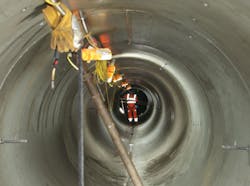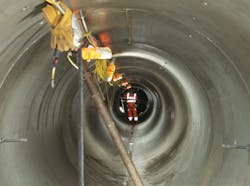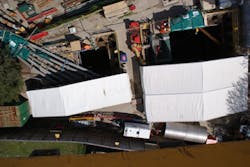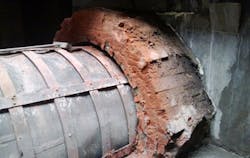Crossrail Close Call--Strengthening Project Protects Sewer from Tunnel Boring Machines
A trencheless solution recently protected London's Ham sewer to enable large diameter tunnel boring machines to pass by extremely closely for London's flagship Crossrail project. Here's why the project has been recognised in multiple awards.
by WWi magazine
Europe's largest construction project, and the biggest single infrastructure project ever undertaken in the UK, Crossrail, is currently halfway to completion. Five years after construction started some six million tonnes of spoil has been removed as the tunnels take shape. But in a heavily developed city like London, the boring of 42 km of tunnels up to 40m is riddled with thousands of potential catastrophes.
Existing underground rail lines, stations, escalators, the foundations of historic buildings and not least the city's vast sewer network, all lay the path of Crossrail's two 7.1 metre diameter Tunnel Boring Machines (TBMs). In east London, the strategically important Ham sewer was one such obstacle. It became the setting for what is believed to be the closest ever pass by a large diameter TBM to a major sewer for this type of work.
Ground movements along the sewer had been previously assessed based upon empirical methods. This had led to the conclusion that there was a high likelihood that ground movements would damage the masonry of the sewer wall. With the two giant 1000 tonne boring machines set to pass just half a metre from the sewer, a unique strengthening project was called for.
Aware of the risks posed to the brickwork, Crossrail engineers searched for examples of protection works for this type of issue. Globally they found 25 comparable projects - none came close to the limited parameters they were working with. This was by far the closest pass by a TBM to such an important and sensitive structure. Various ideas were considered and rejected, including using a huge ultra violet cured Glass Reinforced Plastic (GRP) liner.
Then, in 2011 independent water, wastewater and drainage specialist, UKDN Waterflow, was approached to submit a design that met the stringent technical and regulatory conditions. The trenchless solution it came up with required the installation of two shafts. One shaft to over-pump wastewater flow from the Ham sewer to the nearby Wick sewer, and the other served as an access shaft for installation of a liner.
To bring the plan to fruition, UKDN set about making precision surveys of the large diameter (2.06m) brick sewer using laser burst technology. The findings were then passed to consulting engineering firm, Fairhurst, which helped turn UKDN Waterflow's design into a workable technical solution.
Digging deep
With a plan of action agreed, a temporary works design was put forward by UKDN. Initial work included reinforcing the HAM sewer with a temporary protective metal and rubber installation support cage to enable the creation of the two shafts.
Temporary liners protected the sewer as massive sheet piling girders made safe the access and over-pumping shafts. Construction firm DSJV sheet piled both shafts using a Giken silent piling rig to avoid damage to surrounding buildings and a nearby retaining wall prior to excavation of the shafts.
To enable the dry weather flow from the Ham sewer to be pumped into the Wick sewer a new weir and penstock valve design blocked the flow, diverting it into the pump chamber. Six 300mm pumps were deployed to accommodate a total dry weather sewer flow of 2 m3/second, pumping wastewater up the 14 metre shaft into the adjoining Wick sewer.
During peak flows of up to 8 m3/second the penstock had to be raised to permit the storm flow to pass through the work site. Upstream monitoring, traffic light evacuation procedures, and alarm warnings were established and tested many times during the works. The complex site also hosted construction teams from Murphy, who were simultaneously diverting mains water pipes similarly affected by the tunnel boring works meaning the project working conditions were very tight.
"We used jacking rails fixed to the floor of the sewer with over 400 bolts to guide each 5 metre, 5 tonne section into place," explains Chris Haslam, UKDN Waterflow's principal project manager. "With a design tolerance of only 1mm, we used precision laser guiding and modified gun sighting lasers to ensure three dimensional accuracy."
According to Haslam, the biggest risk was that a section would be out of alignment. However design tolerance was built in to enable slight adjustments to be made and calculations were carried out to determine heave induced by excavation.
The reinforcing liner itself was jacked in on fixed rails in 5 metre sections. The milled ends of each 20mm thick section were joined using full-penetration welds, a process which took 24 hours per section, but created a continuous liner. Full penetration Duplex steel welding is unusual and not normally carried out in a confined space such as a sewer, but was completed in accordance with Standard EN1011 and welding procedure EN15613. The welds were then tested using ultra sonic NDT to EN5817 category C, to ensure a 100% pass rate for all sections. Such welds are more commonly associated with very high pressure pipelines.
The gap between the existing masonry and the liner was grouted through preformed grout holes using cementitious grout. This ensured there were no voids and that the loads from each of the 1.9MW boring machines are transferred onto the new structural lining.
Success
The UKDN's trenchless solution was successfully executed over 20 days, with associated works spread over a number of months. In August 2013 the first TBM successfully passed safely beneath the reinforced section of Ham sewer without incident, the second giant machine made its pass in 2014.
Enabling two 140m long boring machines to navigate past London's subterranean Victorian infrastructure at arm's length may be just one engineering masterstroke among many – but it has not gone unnoticed. In May last year the project scooped the 'Large Renovation' award at the United Kingdom Society for Trenchless Technology 2014 awards.
But it isn't just in the UK where the project has been winning plaudits. In September last year the International Society for Trenchless Technology awarded the UKDN Waterflow its prestigious No –Dig award. It may not have had the glamour of some of Crossrail's associated projects, but the renovation work on Ham's sewer is more than just a boring tale.
This article was put together with help from UKDN. For more information, email: [email protected].
More Water & WasteWater International Archives Issue Articles



